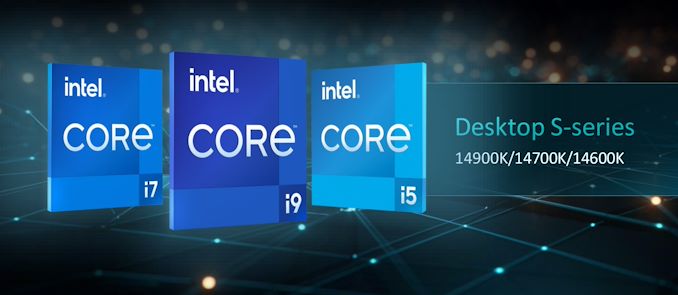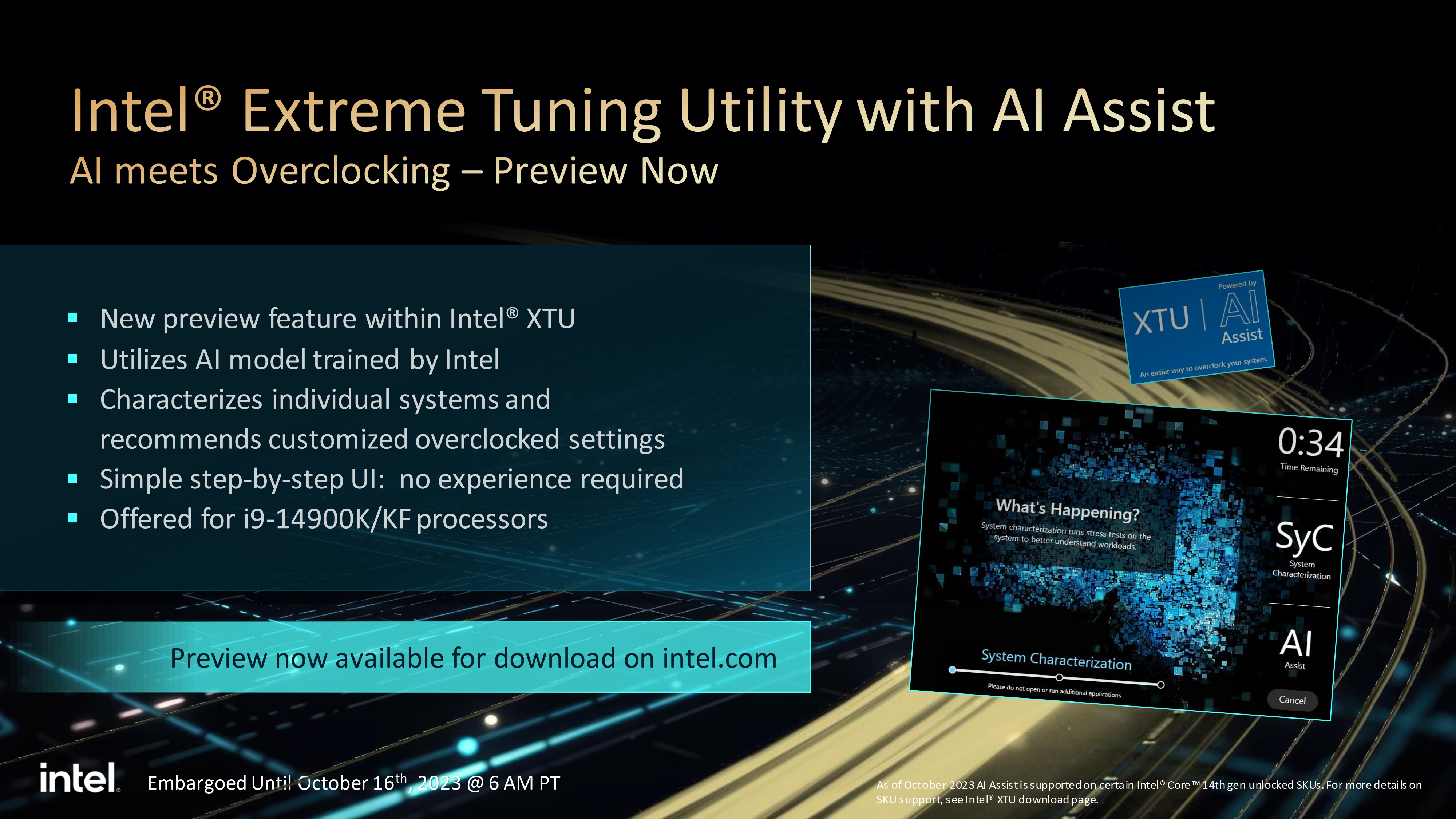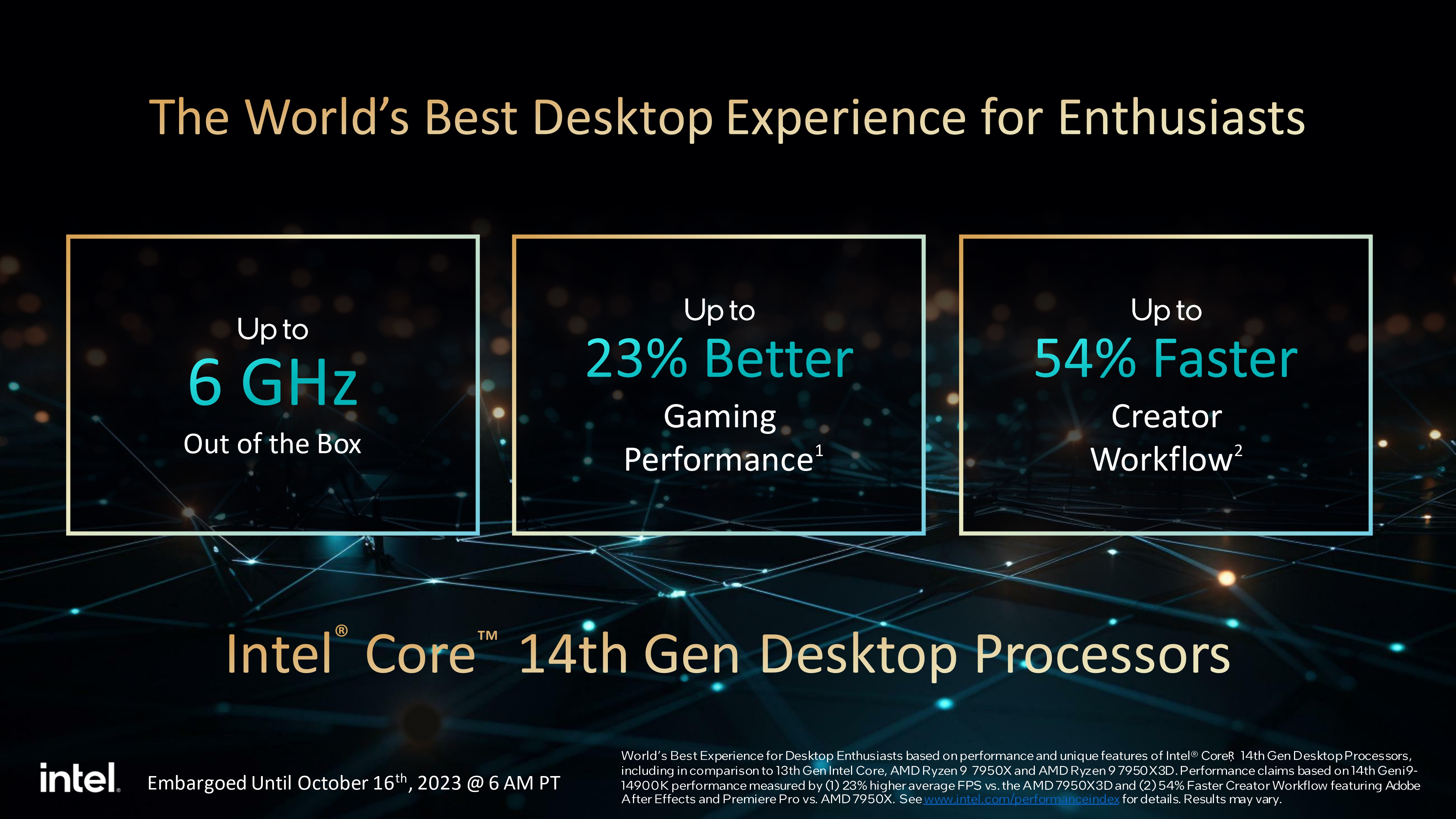Intel Announces 14th Gen Core Series For Desktop: Core i9-14900K, Core i7-14700K and Core i5-14600K
by Gavin Bonshor on October 16, 2023 1:30 PM EST- Posted in
- CPUs
- Intel
- LGA1700
- Raptor Lake
- 14th Gen Core

Ahead of tomorrow's full-scale launch, Intel this afternoon is pre-announcing their 14th Generation Core desktop processors. Aptly codenamed Raptor Lake Refresh, these new chips are based on Intel's existing Raptor Lake silicon – which was used in their 13th generation chips – with Intel tapping further refinements in manufacturing and binning in order to squeeze out a little more performance from the silicon. For their second iteration of Raptor Lake, Intel is also preserving their pricing for the Core i9, i7, and i5 processors, which aligns with the pricing during the launch of Intel's 13th Gen Core series last year.
Headlining the new lineup is Intel's latest flagship desktop processor, the Core i9-14900K, which can boost up to 6 GHz out of the box. This is the second Intel Raptor Lake chip to hit that clockspeed – behind their special edition Core i9-13900KS – but while that was a limited edition chip, the Core i9-14900K is Intel's first mass-produced processor that's rated to hit 6 GHz. Under the hood, the i9-14900K uses the same CPU core configuration as the previous Core i9-13900K chips, with 8 Raptor Cove performance (P) cores and 16 Gracemont-based efficiency (E) cores, for a total of 24 CPU cores capable of executing on 32 threads.
| Intel 14th Gen Core, Raptor Lake-R (K/KF Series) Pricing as of 10/16 |
||||||||||
| AnandTech | Cores P+E/T |
P-Core Base |
P-Core Turbo |
E-Core Base |
E-Core Turbo |
L3 Cache (MB) |
iGPU | Base W |
Turbo W |
Price ($) |
| i9-14900K | 8+16/32 | 3200 | 6000 | 2400 | 4400 | 36 | 770 | 125 | 253 | $589 |
| i9-14900KF | 8+16/32 | 3200 | 6000 | 2400 | 4400 | 36 | - | 125 | 253 | $564 |
| i9-13900K | 8+16/32 | 3000 | 5800 | 2200 | 4300 | 36 | 770 | 125 | 253 | $537 |
| i7-14700K | 8+12/28 | 3400 | 5600 | 2500 | 4300 | 30 | 770 | 125 | 253 | $409 |
| i7-14700KF | 8+12/28 | 3400 | 5600 | 2500 | 4300 | 30 | - | 125 | 253 | $384 |
| i7-13700K | 8+8/24 | 3400 | 5400 | 2500 | 4200 | 30 | 770 | 125 | 253 | $365 |
| i5-14600K | 6+8/20 | 3500 | 5300 | 2600 | 4000 | 24 | 770 | 125 | 181 | $319 |
| i5-14600KF | 6+8/20 | 3500 | 5300 | 2600 | 4000 | 24 | - | 125 | 181 | $294 |
| i5-13600K | 6+8/20 | 3500 | 5300 | 2600 | 3900 | 24 | 770 | 125 | 181 | $285 |
Moving down the stack, arguably the most interesting of the chips being announced today is the new i7-tier chip, the Core i7-14700K. Intel's decision to bolster the core count of its Core i7 is noteworthy: the i7-14700K now boasts 12 E-cores and 8 P-cores, 4 more E-cores than its 13th Gen counterpart – and only 4 behind the flagship i9. With base clock rates mirroring the previous generation's Core i7-13700K, the additional efficiency cores aim to add extra range in multitasking capabilities, designed to benefit creators and gamers.
Rounding out the 14th Gen Core collection is the i5 series. Not much has changed between the latest Core i5-14600K and the Core i5-13600K, with the only differences coming in E-core turbo frequencies; just a 100 MHz uptick here. Both families share the same 6P+8E (20T) configuration, 5.3 GHz P-core turbo, and 3.5 GHz P-core base frequencies. Price-wise (at the time of writing), the Core i5-13600K is currently available at Amazon for $285, which is a $34 saving over the MSRP of the Core i5-14600K, and that money could potentially be spent elsewhere, such as storage or memory.
Since the Intel 14th and 13th Gen core series are essentially the same chips but with slightly faster frequencies, Intel has made no changes to the underlying core architecture. Intel does include a new overclocking feature for users looking to overclock their 14th Gen Core i9 processors. Dubbed 'AI Assist,' it enhances things through its Extreme Tuning Utility (XTU) overclocking software. Harnessing AI to provide users with more intelligent options for overclocking settings outside of the traditional look-up tables based on set parameters, Intel's AI Assist goes further. Using various systems with various components such as memory, motherboards, and cooling configurations to train the AI model, Intel claims their in-house AI is constantly being trained to offer users the most comprehensive automatic overclocking settings thus far.
Of course, it should be noted that overclocking does, in fact, void Intel's warranty, so users should use this feature at their own risk.
Intel boasts up to 23% better gaming performance with their in-house testing than Intel's 12th Gen Core series (Alder Lake), the first platform to bring the hybrid core architecture to Intel's desktop lineup. It must be noted that Intel hasn't compared performance directly to 13th Gen (Raptor Lake), likely due to the close similarities both families share: same cores, same architecture, just slightly faster frequencies out of the box.
The Intel 14th Gen chips are designed for the preexisting 600 and 700-series motherboards, which use the LGA 1700 socket. Motherboard vendors have already begun refreshing their Z790 offerings with more modern features, such as Wi-Fi 7 and Bluetooth 5.4, providing motherboard manufacturers decide to integrate them into their refreshed Z790 models. Official memory compatibility remains the same as 13th Gen, supporting DDR5-5600 and DDR4-3200 memory. Though overclockers may find the highest binned chips more capable than before, with Intel teasing speeds beyond DDR5-8000 for their best chips.
The Intel 14th Gen Core family of desktop processors (K and KF) is launching on October 17th at retailers and system integrators. Pricing-wise, the flagship Core i9-14900K costs $589, the Core i7-14700K will be available for $409, and the more affordable Core i5-14600K for $319.
Source: Intel




_page-0001_thumb.jpg)
_page-0002_thumb.jpg)
_page-0003_thumb.jpg)
_page-0004_thumb.jpg)
_page-0005_thumb.jpg)
_page-0006_thumb.jpg)








30 Comments
View All Comments
shabby - Monday, October 16, 2023 - link
100-200mhz bumps lolshabby - Monday, October 16, 2023 - link
Only the 700k has a descent core bump, the rest are junkFlunk - Monday, October 16, 2023 - link
ZZZZ, why bother?kpb321 - Monday, October 16, 2023 - link
Okay so they released the i9-13900KS as a regular chip for the i9-14900K and the higher end i7 chips are now partially binned i9 chips. Pretty big yawn. No wonder they are fine announcing these ahead of time. Maybe it will push the prices of 12th and 13th gen chips down even more making them even better options but this is the non-upgrade I think pretty much everyone expected.Duwelon - Monday, October 16, 2023 - link
What are desktop users (i.e. gamers) supposed to do with 8+ E cores? Do they assist gaming workloads even a little bit? Whats the point of them on desktop again?Tom_Yum - Monday, October 16, 2023 - link
To win multicore benchmark scores.wrosecrans - Monday, October 16, 2023 - link
The short answer is that 8 extra cores is no particular benefit to somebody playing a video game. No current game requires that many cores because the market for such a game would be vanishingly small.If you have a zillion browser tabs open to crappy pages with JS that burns cycles, it can be helpful. Which is kinda sad that so many modern web pages have gotten so bad that looking at the web is a serious driver for faster CPU's. But the main benefit is folks doing things like content creation. If you are rendering CGI while also editing video, you can't have too many cores. Or if you are a developer working on big projects, being able to build across more cores can be a big help. (Though at this point, some real world applications have fewer source files than a modern desktop has cores. So if you mainly work on tiny utilities, even developers may start to see a point of diminishing returns with more cores!)
Duwelon - Monday, October 16, 2023 - link
I wonder if we're not just witnessing an AI-driven fad. I built a 16 core machine 3 years ago (zen 3) thinking I'd get a lot of use out of it with ML-driven photo editing / enhancement tools. The technology is good for niche cases but it's very primitive, not ready for commercial use in many cases, at least not when it's obvious it's computer generated. In other words, are the vast majority of these E Cores doing absolutely nothing?nandnandnand - Wednesday, October 18, 2023 - link
We haven't even seen dedicated AI accelerators reach Intel and AMD desktop lineups yet (they are already in Phoenix and Meteor Lake), which they might do within the next 2 years.Samus - Tuesday, October 17, 2023 - link
Exactly this. Bearing in mind that most games are built around an 8-core ecosystem (due to the XBOX and PS5 being such) it's doubtful PC ports, or PC games that may be ported to consoles, will be designed around utilizing more than 8 cores. The fact is most AAA games are still GPU limited on the most powerful CPU's.Elsewhere, in other applications, cores are incredibly useful, but not to most typical desktop users. Compression\decompression benefit tremendously as does any other multithreaded task. But with rendering, especially AI plugins for Adobe etc, using GPU acceleration, CPU performance again is becoming less critical.
And this is why Intel can get away with calling 13th gen parts 14th gen parts: nobody cares.